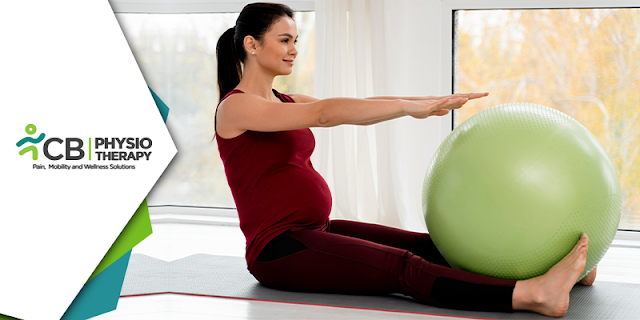Best Exercises During Pregnancy For Each Trimester
Exercise during pregnancy is generally safe for most women and can have many benefits for both the mother and the baby. Regular physical activity can help improve mood, increase energy levels, prevent excessive weight gain, and improve sleep. Additionally, exercise during pregnancy can also improve cardiovascular fitness, muscle strength, and prepare the body for the physical demands of labor and delivery. However, it's important to consult a physiotherapist before starting or continuing any exercise regimen during pregnancy, especially if you have any medical conditions or complications. In this blog, we will discuss the exercises that can be done during pregnancy along with their benefits,
Some women may need to modify their physical activity or avoid certain exercises during pregnancy. In general, low-impact activities such as walking, swimming, and stationary cycling are recommended during pregnancy. High-impact activities, such as running, and activities that have a risk of falling or abdominal trauma, such as contact sports, should be avoided.
Guideline for Exercising During different Phases of Pregnancy:
1st Trimester (0-12 weeks):
During this phase, most women have relatively normal energy levels. Light to moderate exercises such as walking, swimming, and stationary cycling are safe and can help reduce fatigue and stress. It's important to avoid high-impact activities and activities that involve jumping, bouncing, or rapid changes of direction.During the first trimester of pregnancy, it's important to engage in physical activities that are gentle, low-impact, and safe for both you and your baby. Stretching and strengthening exercises can help to maintain good posture, reduce aches and pains, and prepare your body for the physical demands of pregnancy and childbirth. Some stretching and strengthening exercises that can be done during the first trimester of pregnancy include:
- Pelvic curls are a great way to begin working on spinal mobility and strengthening the abdominal muscles that support your belly as it grows.
- Bicep curls help prepare your arms for repeatedly lifting and holding your baby.
- Kneeling push-ups, this exercise targets the core and upper body strengthening together.
- Cat-Cow stretching exercises help to relieve lower back pain and improve posture),
- Hamstring stretches help to relieve tightness in the back of the legs),
- Leg Swings help to improve circulation and relieve tension in the legs),
- Pelvic brace or Kegels exercise helps to strengthen the pelvic floor muscles, which support the uterus and help prevent urinary incontinence),
- Squats help to strengthen the legs and prepare them for the physical demands of childbirth),
- Arm and Shoulder strengthening exercises help to improve posture and reduce discomfort in the upper body.
2nd Trimester (13-28 weeks):
As the baby grows and the mother's body changes, it's important to continue to modify the exercise. Avoid exercises that involve lying on your back, as this can decrease blood flow to the baby. Swimming and stationary cycling are still great options, but resistance training can also be added, focusing on the upper body, legs, and core.During the second trimester of pregnancy, it is generally safe to perform low-impact exercises, such as:
- Incline pushups, target the shoulder, triceps, and chest.
- Hip and knee flexor stretching exercises are done as the center of gravity changes and the belly tends to fall forward, creating shortened hip flexor muscles.
- Mermaid stretching exercises can also be done as the baby grows, it can start to create pressure on the diaphragm and ribs that can be painful.
- Side-lying leg lifts help to prepare for the changing center of gravity, it’s important to get the muscles that help with balance and assist in pelvic stabilization stronger.
- Pelvic Tilts, This exercise helps to strengthen the lower back and abdominal muscles.
- Squats, target the legs, glutes, and core muscles.
- Wall push-ups help to strengthen the chest, arms, and shoulder muscles.
- Leg Lift Exercise helps strengthen the legs, hips, and lower back muscles.
- Bridging exercise helps strengthen the glutes, hamstrings, and lower back muscles.
- Cat-Cow Stretch exercise stretches the spine and neck muscles.
- Hamstring Stretching exercise stretches the hamstrings, hips, and lower back.
- Child's Pose exercise stretches the hips, back, and legs.
- Butterfly Stretch exercise stretches the hips, inner thighs, and lower back.
- Seated Straddle Stretch exercise stretches the inner thighs and hips.
3rd trimester (29-40 weeks):
During this phase, the baby is growing rapidly, and the mother's body is undergoing significant changes. Exercise may become more challenging, and it's important to listen to your body and adjust the intensity and duration of exercise as needed. Gentle activities such as walking and swimming can help keep the mother active and maintain good cardiovascular health. During the third trimester of pregnancy, it is important to focus on exercises that help prepare the body for labor and delivery as it's important to stay active and maintain strength and flexibility to support your changing body.Here are some therapeutic exercises that can be done during the third trimester:
- Diastasis recti correction exercises are done to combat the separation of the rectus abdominal muscles during pregnancy and it shows up as a bulge that runs down the midline of the abdomen,
- Pelvic Tilts, this exercise helps strengthen your lower back and pelvic muscles.
- Kegels, Kegels help to strengthen your pelvic floor muscles, which support your bladder, uterus, and rectum. To do Kegels, squeeze the muscles you would use to stop urinating, hold for 5-10 seconds, then relax. Repeat 10-15 times.
- Cat-Cow Stretch, Wall Squats, and Hamstring Stretch can be continued in this phase also.
- Leg and foot stretch exercises help to relieve cramps and improve blood circulation.
- Pigeon Pose: Start on all fours, then bring one knee forward to your hand and the other leg behind you. Keep your back straight and hold for 30 seconds, then switch sides.
Exercises to avoid during pregnancy include:
Exercises that should be avoided during pregnancy include activities that have a risk of falling, such as horseback riding, ice skating, and gymnastics, as well as activities that have a risk of an abdominal injury, such as contact sports.- Scuba diving can lead to changes in pressure and nitrogen absorption, which can be harmful to the developing fetus.
- Lying on your back can cause decreased blood flow to the fetus, so exercises that involve this position should be avoided.
- Intense cardio or High-intensity cardio workouts, such as running and jumping, can cause stress on the joints and increase the risk of injury.
- Weightlifting during pregnancy can put extra strain on the back and lead to injury.
Exercising during pregnancy has many benefits, such as improving mood, increasing energy levels, reducing the risk of gestational diabetes, and helping with weight management. However, it's important to understand that the type and intensity of exercise may need to be modified throughout pregnancy to ensure the safety of both the mother and the baby.

